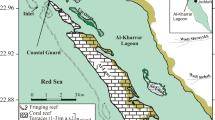Abstract
A marginal pond on the eastern coast of the southern part of the Dead Sea in Jordan receives fresh and thermal waters from adjacent areas. The pool has a narrow “intertidal” zone in which halite-encrusted stromatolites flourish. The muddy sediments of the pond consist of a mixture of detrital clay minerals and calcite with authigenic halite and dolomite. The association of halite with dolomite supports the assertion that dolomite is an evaporitic mineral. The absence of gypsum in these sediments is attributed to bacterial reduction of sulfates.
Similar content being viewed by others
References
ABED, A.M., 1985, Geology of the Dead Sea: evolution, water, salts and the two seas canal. Dar Al-Arkam, Amman, Jordan, 233 p. (in Arabic).
ALMOGI-LABIN, A., PERELIS, G.L., and RAAB, M., 1992, Living Ammonia from a hypersaline inland pool, Dead Sea area, Israel:Journal of Foraminiferal Research, v. 22, p. 257–266.
BEGIN, Z.B., 1975, Paleocurrents in the Pleistocene Samra formation (Jericho) and their tectonic implications:Sedimentary Geology, v. 14, p. 191–218.
BEGIN, Z.B., EHRLICH, A., and NATHAN, Y., 1974, Lake Lisan, the Pleistocene precursor of the Dead Sea:Geological Survey of Israel Bulletin, no. 63, p. 1–30.
BENTOR, Y., 1961, Some geochemical aspects of the Dead Sea and the question of its age:Geochimica Cosmochima Acta, v. 25, p. 239–260.
BRAITHWAITE, C.J.R. and ZEDEF, V., 1996, Hydromagnesite stromatolites and sediments in an alkaline lake, Salda Golu, Turkey:Journal of Sedimentary Research, (Section A-Sedimentary Petrology & Processes), v. 66, p. 991–1002.
BUSSON, G., NOEL, D., CONTINI, D., MANGIN, A.M., CORNEE, A., and HANTZPERGUE, P., 1993, Omnipresence de coccoliths dans des calcaires lagunaires du Jurassique moyen et superieur de France:Bulletin Centre de Recherche Exploration Production Elf-Aquitaine, v. 17, p. 291–301.
CHAFETZ, H.S., RUSH, P.F., and SCHODERBEK, D., 1987, Black stromatolites of Pennsylvanian age; an ancient analogue to the Mn-rich sub-Recent stromatolites from the Dead Sea: Abstracts, Society of Economic Paleontologists and Mineralogists, Annual Midyear Meeting, p. 15.
FREYTET, P. and VERRECCHIA, E.P., 1998, Freshwater organisms that build stromatolites-a synopsis of biorecrystallization by prokaryotic and eukaryotic algae (review):Sedimentology, v. 45, p. 535–563.
FRIEDMAN, G.M., 1995, Diverse origin of modern dolomite in the Levant:Carbonates and Evaporites, v. 10, p. 65–78.
GOLDHABER, M., 1978, Euxinic facies.In R.W. Fairbridge and J. Bourgeois, eds., Encyclopedia of Sedimentology. Dowden, Hutchinson and Ross, p. 296–300.
HERUT, B., GAVRIELI, I., and HALICZ, L., 1997, Sources and distribution of trace and minor elements in the western Dead Sea surface sediments:Applied Geochemistry, v. 12, p. 497–505.
KAUFMAN, A., YECHIELI, Y., and GARDOSH, M., 1992, Reevaluation of the lake-sediment chronology in the Dead Sea Basin, Israel, based on new Th/U dates:Quaternary Research, v. 38, p. 292–304.
LIVANT, A. and KRONFELD, J., 1990, Pleistocene lakes in the Arava Rift of Israel (Sayif Formation): facies and paleoenvironmental setting:Journal of African Earth Sciences, v. 10, p. 409–420.
MATRAI, P.A. and KELLER, M.D., 1993, Dimethylsulfide in a largescale coccolithophore bloom in the Gulf of Maine:Continental Shelf Research, v. 13, p. 831–843.
NISHRI, A., 1984, The geochemistry of manganese and iron in the Dead Sea:Earth and Planetary Science Letters, v. 71, p. 415–426.
NISSENBAUM, A., STILLER, M. and NISHRI, A., 1990, Nutrients in pore waters from Dead Sea sediments:Hydrobiologia, v. 197, p. 83–89.
NOEL, D., BUSSON, G., CORNEE, A., and MANGIN, A.M., 1993, Les coccolithophoridees fossiles ne peuvent plus etre considerees comme caracteristique du seul environment pelagique:Bulletin Societe Geologique de France, v. 164, p. 493–502.
OREN, A., GUREVICH, P., ANATI, D.A., BARKAN, E., and LUZ, B., 1995, A bloom ofDunaliella parva in the Dead Sea in 1992: biological and biogeochemical aspects:Hydrobiologia, v. 297, p. 173–185.
ROBINSON, N.D., 1995, Biogenic acid rain during the late Cretaceous as a possible cause of extinction:Journal of the Geological Society (London), v. 152, p. 4–6.
ROSENTHAL, Y., KATZ, A., and TCHERNOV, E., 1989, The reconstruction of Quaternary freshwater lakes from the chemical and isotopic composition of gastropod shells: the Dead Sea Rift, Israel:Palaeogeography, Palaeoclimatology, Palaeoecology, v. 74, p. 241–253.
SALAMEH, H.S., 1997, Geomorphology of the eastern coast of the Dead Sea, Jordan:Geo Journal, v. 41, p. 255–266.
SHATKAY, M. and MAGARITZ, M.TI, 1987, Dolomitization and sulfate reduction in the mixing zone between brine and meteoric water in the newly exposed shores of the Dead Sea:Geochimica et Cosmochimica Acta, v. 51, p. 1135–1141.
VANKAAMPETERS, H.M.E. and DAMSTE, J.S.S., 1997, Characterisation of an extremely organic sulphur-rich, 150 Ma old carbonaceous rock-palaeoenvironmental implications:Organic Geochemistry, v. 27, p. 371–397.
WATZMAN, H., 1997, Left for dead:New Scientist, no. 2068, (Feb 8), p. 37–41.
YAKIR, D. and YECHIELI, Y., 1995, Plant invasion of newly exposed hypersaline Dead Sea shores:Nature, v. 374(6255), p. 803–805.
YECHIELI, Y. and RONEN, D., 1997, Early diagenesis of highly saline lake sediments after exposure:Chemical Geology, v. 138, p. 93–106.
Author information
Authors and Affiliations
Rights and permissions
About this article
Cite this article
Sadooni, F.N., Saqqa, W. & Abrahim, G. Recent sediments from a coastal pond, eastern margin of the Dead Sea, Jordan. Carbonates Evaporites 17, 79–86 (2002). https://doi.org/10.1007/BF03175659
Published:
Issue Date:
DOI: https://doi.org/10.1007/BF03175659




